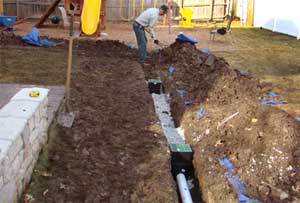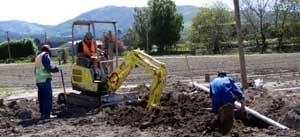Drainlayer
Tasks & duties

Drainlayers may do some or all of the following:
-
examine the plans, drawings and land that the drains or waste water treatment systems are to be laid in
-
consult with clients and other tradespeople about where the drains or waste water treatment systems are to be laid or repaired
-
prepare quotes if self-employed
-
obtain consent from the local council to undertake work on drains
-
excavate and dig trenches along areas marked on the plans
-
protect the trenches from collapse
-
measure and cut the pipes
-
install drains by laying pipes and putting in fittings
-
work out gradients and falls using laser-levels
-
seal all waterjoints on the pipes
-
repair and clear blockages in drains
-
backfill trenches after they have been tested by local council inspectors using recommended fill such as gravel
-
install manholes
-
install waste water treatment systems in rural areas
-
erect road signs to warn drivers of work being done on the road
-
give advice on drainage issues
Specialisations
Drainlayers may specialise in residential or commercial work.
Skills & knowledge

Drainlayers need to have:
-
knowledge of different drainage methods and materials
-
the ability to read drainage plans
-
knowledge of the laws and by-laws relating to drainlayers and drainlaying
-
practical skills for laying and repairing drains
-
basic maths skills for making accurate measurements
-
good communication skills, as they deal with a range of people including clients and the public
-
planning and organisational skills
-
knowledge of health and safety procedures, including first aid skills, as their work may be dangerous
Drainlayers who are self-employed also need business skills.
Entry requirements
To become a drainlayer you must work under the supervision of a registered drainlayer and complete an approved course in drainlaying through the Plumbing, Gasfitting and Drainlaying Industry Training Organisation, pass drainlaying unit standards and obtain the National Certificate in Drainlaying.
Secondary education
A minimum of three years of secondary education is recommended.
Training on the job
Skills are gained on the job. Training courses are available to keep up to date with new technology, safety procedures and other developments in drainage, plumbing and gasfitting. Drainlayers may also receive training in operating heavy machinery and can complete courses to become registered plumbers and gasfitters.
Registration
Only registered drainlayers who are licensed have the authority to lay drains or supervise others doing so.
To become registered, you must be qualified and complete an approved course in drainlaying through the Plumbing, Gasfitting and Drainlaying Industry Training Organisation. You must then apply for registration with the Plumbers, Gasfitters and Drainlayers Board.
Useful experience
Useful experience for drainlayers includes:
- work in the building construction industry
- experience driving trucks or mechanical diggers
- any work involving physical labour
Related courses
Plumbing, Gasfitting and Drainlaying
For more information, please refer to Career Services.
Document Actions
